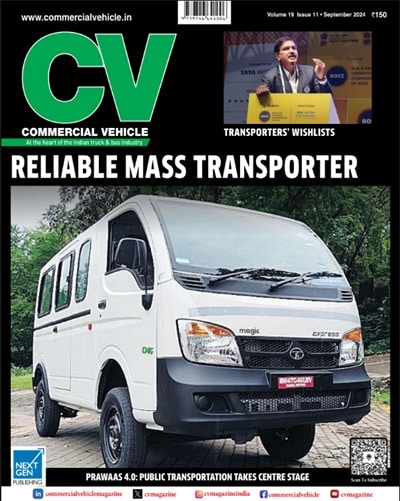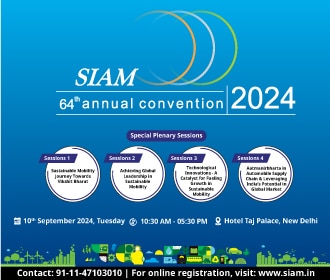Q & A
Anant J Talaulicar, Managing Director, Cummins Group India
Interview by: Ashish Bhatia
Q. Cummins and Tata Motors have had a long association. How do you look at the journey?
A. Cummins and Tata Motors have been partners for 23 years. The 50:50 joint venture partnership between the two companies dates back to 1993. Production at Tata Cummins started in 1995 at Jamshedpur. It still continues. We began operations with a production capacity of 60,000 engines per annum. The production has since doubled to 120,000 engines per annum. Even that was found to be insufficient, and we duplicated the capacity at the Cummins megasite at Phaltan near Satara. The campus at Phaltan houses seven factories. These include components for the entire engine. The megasite has added another 120,000 engines to the capacity, taking it to 240,000 engines per annum. Tata and Cummins, as partners, have expanded capacities to meet the demand in the country. We brought new technology into India in 2000. The same year India began moving towards cleaner engines. Initially BS I, BS II, BS III and now on the verge of BS IV. There will be pan-India implementation of BS IV in April next year. So we have partnered with them (Tata) absolutely hand-in-hand throughout the journey.
Q. You are increasing capacity at a time the industry is struggling with over capacity. Why?
A. In the financial year 2005, the Indian economy was booming. We touched 90 per cent utilisation levels by the 2011 financial year. The 2011 financial year was the peak year. We found out that we are unable to provide enough to the market. We were actually on the back foot at that time. We were fully utilised, running three shifts, seven days a week. We therefore decided to add significant capacity in India. Thereafter, contrary to our predictions, the Indian economy was throttled, courtesy the lack lustre policies of the government in power then. It is necessary to understand that trucks are capital goods. They are simply not a piece of cosmetics, which is bought. As things start to get tough in terms of the economy, it is the commercial vehicles that are impacted foremost. Interest rates and inflation went up; demand went down. This created the worst possible scenario. Fortunately with the new government, we are witnessing a revival. For the record, we have adequate exposure in diverse fields including the generator industry. We also cater to off-highway construction, mining equipment, railways and the marine segment.
Q. Do you see the market reviving itself?
A. The private sector is yet to join the growth bandwagon fully. It is still reeling under the challenge of over capacity. Green shoots are visible however and revival has started based upon government spending. A thrust on infrastructure, defence and mining has resulted in action. The commercial vehicle industry grew almost 30 per cent last year. Especially the Medium and Heavy Commercial Vehicle (M&HCV) segment. Growth so far looks sustainable. If the economy continues to grow, there will be improvement. Slowly the private sector will start joining. Capacity utilisation will go up and create room for fresh investments. GST and an investment in world-class infrastructure will put the economy on the fast track to growth. There is substantial pent-up demand. The need is to make certain that the policies are growth oriented. India makes an attractive destination for global sourcing activities. Not only can the demands of this country be catered to, one can export too. Tata Motors is also aiming in this direction. The key export markets include Africa, the Middle-East among others.
Q. How is Cummins planning to take advantage of the market reviving?
A. The government is taking a very aggressive stance towards achieving zero emission. We are planning to move towards BS VI by April 2020. As of now, we have not even reached BS IV pan-India. That will happen on April 2017. There are only four years to leap from four (BS IV) to six (BS VI). No country has set a precedence of doing something like this; of having skipped the BS V emission level. What will happen is, a BS VI diesel engine will turn into an air filter. It will start cleaning up the ambient air and that’s where Cummins is looking at playing a central role. The combustion system, pistons, piston rings, shapes of the bowl and the turbocharger will become a technology that can also clean-up. People until now would have thought that these were about adding a boost. Technology will move from simpler fixed-geometry turbochargers to waste gate turbo chargers and then to variable geometry turbochargers. On the fly, it would be possible to modify the combustion process such that the air maintains the appropriate heat. There are advanced aftertreatment systems which control Nitrogen Oxide (NOx) called Selective Catalytic Reduction (SCR) devices, and filters for particulates and hydrocarbons called Diesel Particulate Filters (DPF). Cummins has both the technologies; turbochargers and fuel systems that are much more advanced. The fuel systems as of current may be mechanical in nature. It may be possible to repair them under the shade of a tree. However, BS VI fuel system will be a high pressure electronically controlled fuel system with much higher cylinder and injection pressure to atomise the fuel so that it completely combusts in a clean manner. We expect it to significantly impact our business. We expect it to lead to a positive impact.
Q. How diverse is your portfolio?
A. From a global portfolio perspective we have engines that range from 2.8-litres to 95-litres. We are looking at bringing our smaller engines and localising them in India. We have designed and are manufacturing 2.8-litre and 3.8-litre advanced Euro-VI engines. We are looking at bringing this portfolio to India. Similarly in mining, we will be bringing in large capacity engines (60-litre) to India.
Q. How far has work come on integrating telematics?
A. Trucks with BS IV compliance level have some amount of telematics integrated. Going forward we will have advanced telematics with a higher set of features for the truck drivers and fleet operators. It will help them in optimising the cost of their operation. Today, one essentially gets online data on the engine and vehicle performance in real time. This can be used to optimise the truck operations that help to lower fuel economy and enhance safety. We as Original Equipment Manufacturers (OEMs) can also get this information in real time. All this is well within the realm of possibility.
GST and an investment in world-class infrastructure will put the economy on the fast track to growth.





























